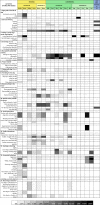A framework for understanding how activities associated with dog ownership relate to human well-being
- PMID: 32647301
- PMCID: PMC7347561
- DOI: 10.1038/s41598-020-68446-9
A framework for understanding how activities associated with dog ownership relate to human well-being
Abstract
There is notorious inconsistency regarding mental health benefits of dog ownership, partially due to repeated cross-sectional studies comparing dog owners and non-owners, without taking into account the heterogeneity of dog-owner dyads, especially the activities with which the owners are involved. This study aimed to develop a comprehensive framework of the most important dog human related activities and their impact on owner well-being. Six focus groups with 35 dog owners were conducted, and their audio transcripts thematically analysed. Dog human related activities and themes of activities were linked to their reported changes in well-being through matrix coding. A framework of 58 dog human related activities linked with their specific hedonic well-being, life satisfaction and eudaimonic well-being outcomes was generated. Most activities were reported to improve owner's well-being, (e.g. human-dog tactile interaction increases owner's self-esteem), and a minority was mainly associated with negative outcomes. The richness of the framework presented in this study reinforces the importance of assessing dog ownership well-being outcomes based on specific dog human related activities with which dog owners are involved. This new and systematic investigative approach should decrease inconsistencies in the field and facilitate mental health interventions and study designs of a higher level of evidence.
Conflict of interest statement
The authors declare no competing interests.
Figures




References
-
- Vos T, Barber RM, Bell B, Bertozzi-Villa A, Biryukov S, Bolliger I, Charlson F, Davis A, Degenhardt L, Dicker D, Duan L. Global, regional, and national incidence, prevalence, and years lived with disability for 301 acute and chronic diseases and injuries in 188 countries, 1990–2013: a systematic analysis for the global burden of disease study 2013. Lancet. 2015;386:743–800. doi: 10.1016/S0140-6736(15)60692-4. - DOI - PMC - PubMed
-
- Mental Health Taskforce. The Five Year Forward View for Mental Health—A Report from the Independent Mental Health Taskforce to the NHS in England. https://www.england.nhs.uk/wp-content/uploads/2016/02/Mental-Health-Task... (2016).
-
- Hall S, Dolling L, Bristow K, Fuller T, Mills DS. Companion Animal Economics: The Economic Impact of Companion Animals in the UK. Wallingford: CABI; 2017.
-
- Evans-Wilday AS, Hall SS, Hogue TE, Mills DS. Self-disclosure with dogs: dog owners’ and non-dog owners’ willingness to disclose emotional topics. Anthrozoös. 2018;31:353–366. doi: 10.1080/08927936.2018.1455467. - DOI
Publication types
MeSH terms
LinkOut - more resources
Full Text Sources

